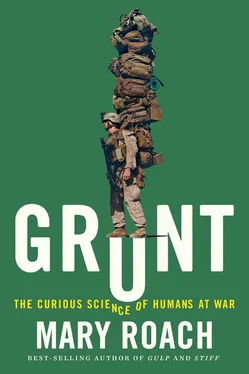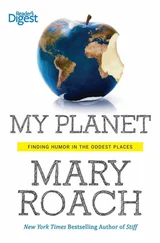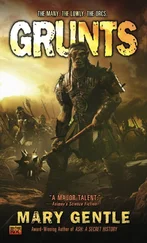IN WORLD War II they called it deck-slap. Explosions from underwater mines and torpedoes would propel a ship’s decks upward, smashing sailors’ heel bones. Like “combat fatigue” for post-traumatic stress disorder, it was a cavalier toss-off of a name for what would often turn out to be a life-altering condition. The calcaneus (the heel) is tough to break, tougher still to repair. By one early paper’s count, eighty-four different approaches had been tried and discussed in medical journals. Dressings of lint and cottage cheese. “Benign neglect.” “Mallet strikes to break up fracture fragments” followed by “manual molding” to recreate a heel-like shape. Few statistics from the era exist, but one paper cites an amputation rate of 25 percent.
Underbody blasts have brought heels back to the attention of military surgeons. The mallets and lint have been replaced with surgery and pins, but the amputation rate for deck-slap injuries is higher than ever—45 percent, in one recent review of forty cases. Part of the problem has to do with fat, not bone. The calcaneal fat pad keeps the bone from abrading the skin on the underside of the heel. It’s an extremely dense, fibrous fat found nowhere else in the body. (There’s enough squish there to merit the cobbler’s term “breast of the heel.”) Fat pads are frequently damaged in underbody blasts, sometimes badly enough that they have to be removed. Without the padding, the pain of walking is acute. When vitamin A poisoning caused the soles of Antarctic explorer Douglas Mawson’s feet to slough off, he stuffed them in the bottom of his boots like Dr. Scholl’s cushioning insoles. It was the only way he could go on.
Can’t something be put in to replace a damaged fat pad? I spoke to orthopedic surgeon Kyle Potter, who works with these patients at Walter Reed National Military Medical Center. “You mean like a small silicone breast implant?” I wasn’t actually thinking that, but sure.
“No.” Potter pointed out that breast implants aren’t designed to stand up to the forces of heel strike. Walking pounds the calcaneus with 200 percent of a person’s body weight; running, as much as 400 percent. Rupture and leakage would likely be issues. At best, Potter said, it would feel very strange. It would feel like someone stuck a breast implant in your shoe. And who, other than Douglas Mawson, would want that?
In half an hour, some deck-slap will be broadcast live on the video monitors in the bunker. We’re all over there now, while the explosives team readies the bomb. There’s not much else in here. Some microwave ovens for warming engineered soil (“DIRT ONLY,” they are labeled). An earplug dispenser by the door. The plugs are pastel foam, shot through with sparkles. It seems like a lot of manufacturing bother just to be able to call your product Spark Plugs. A wall clock shows the wrong time. “No one can figure out the admin system for the clocks,” a man explains. “We can’t spring forward and fall back.”
We stand and stare at the video feed. A slight breeze moves the trees beyond the tower. Someone with a working timepiece begins a countdown. The explosion sounds muffled, less by earplugs than by distance. We’re a half-mile away. The cadavers appear to be thrown by the blast, but not in an action-movie way. More of a took-a-speed-bump-too-fast way. As with an automotive “crash test,” the language is more disturbing than the actual event. The cadavers in an underbody blast test are blown up, as in upward, not apart .
The event is filmed at 10,000 frames per second. Playing back the footage at 15 or 30 frames per second allows the researchers to step inside the half-second lifespan of the event. Now we can see what in real time we could not. First the boots flatten, their sides bulging noticeably. An index finger rises from where it was resting on a thigh, as though the cadaver were about to make a point. The lower legs extend and rise. The head comes down and the arms shoot out in the manner of a hurdler mid-leap. Coates reverses the footage and directs me to watch the spine. As the energy of the blast moves to the seat pan, the dead man’s pelvis rises, shortening his torso and expanding his paunch. Underbody blast can compress a seated soldier’s spine by as much as two inches. Back pain and injuries, no surprise here, are common.
Played at this speed (and in this outfit), it’s modern dance. There’s grace and beauty to the limbs’ extensions, nothing brutish or violent. In real time, though, the forces that move the limbs pass too quickly for the tissue to accommodate. Muscles strain, ligaments tear, bones may break. Imagine pulling apart a wad of Silly Putty. Pull slowly, and it will stretch across the room. Yank it fast and it snaps in two. Likewise, different types of body tissue have different strain rates. For the forces of any given blast, one type may stretch, say, a fifth of its length without tearing, while another may manage just 5 percent. WIAMan will be calibrated to reflect these differences and predict the consequences.
The long-term quality of a soldier or Marine’s life is a relatively new consideration. In the past, military decision makers have concerned themselves more with go/no-go: Do the injuries keep a soldier from completing her mission? Have we lost another pawn in the game? WIAMan will answer that question, but it will answer others, too. Is this soldier likely to have back pain for the rest of his life? Will he limp? Will his heel hurt so much that he’d rather lose the foot? The answers may or may not affect the decisions that are made, but at least they’ll be part of the equation for those inclined to do the math.
BACK IN Building 336, I ask my hosts if it would be okay to try driving a Stryker. It would not. Like an obliging parent, Mark allows me to sit in the driver’s seat and turn the steering wheel back and forth. While everything else within reach seems robustly military-grade, all toggle switches and steel, the steering wheel appears to have been salvaged from a 1990s budget rental car. (And possibly was: General Dynamics, manufacturer of the Stryker, owns Chevrolet.)
Mark ousts me from the driver’s seat so he can repark the vehicle. Brockhoff, pacing at the edge of the parking lot, has found some sort of plastic packing material. She darts over to the Stryker and stuffs it in behind the backmost tire. What follows is a noise you will find nowhere in the publications of military hearing professionals: a 40,000-pound Stryker backing up over an armload of wadded-up bubble wrap.
3. FIGHTING BY EAR
The Conundrum of Military Noise

THE UNITED STATES MARINE Corps buys a lot of earplugs. You find them all around Camp Pendleton: under the bleachers at the firing range, in the bottoms of washing machines. They are effective, and cheap as bullets [13] And, though you didn’t ask for it, here’s one more similarity between bullets and earplugs: Both have been used by physicians to protect their ears from screams. The Army Medical Department Journal states that the real reason soldiers in the pre-anesthesia era were given a bullet to bite was not to help them endure the pain but to quiet their screams. And from a paper called “The History and Development of the E-A-R Foam Earplug” we learn that emergency room docs use foamies “to block the screams of children during difficult procedures.” This was part of a section on “unusual applications,” none of which were especially unusual. I may have had unreasonable expectations for the history of the foam earplug.
(which also turn up in the washing machines). For decades, earplugs and other passive hearing protection have been the main ammunition of military hearing conservation programs. There are those who would like this to change, who believe that the cost can be a great deal higher. That an earplug can be as lethal as a bullet.
Читать дальше













